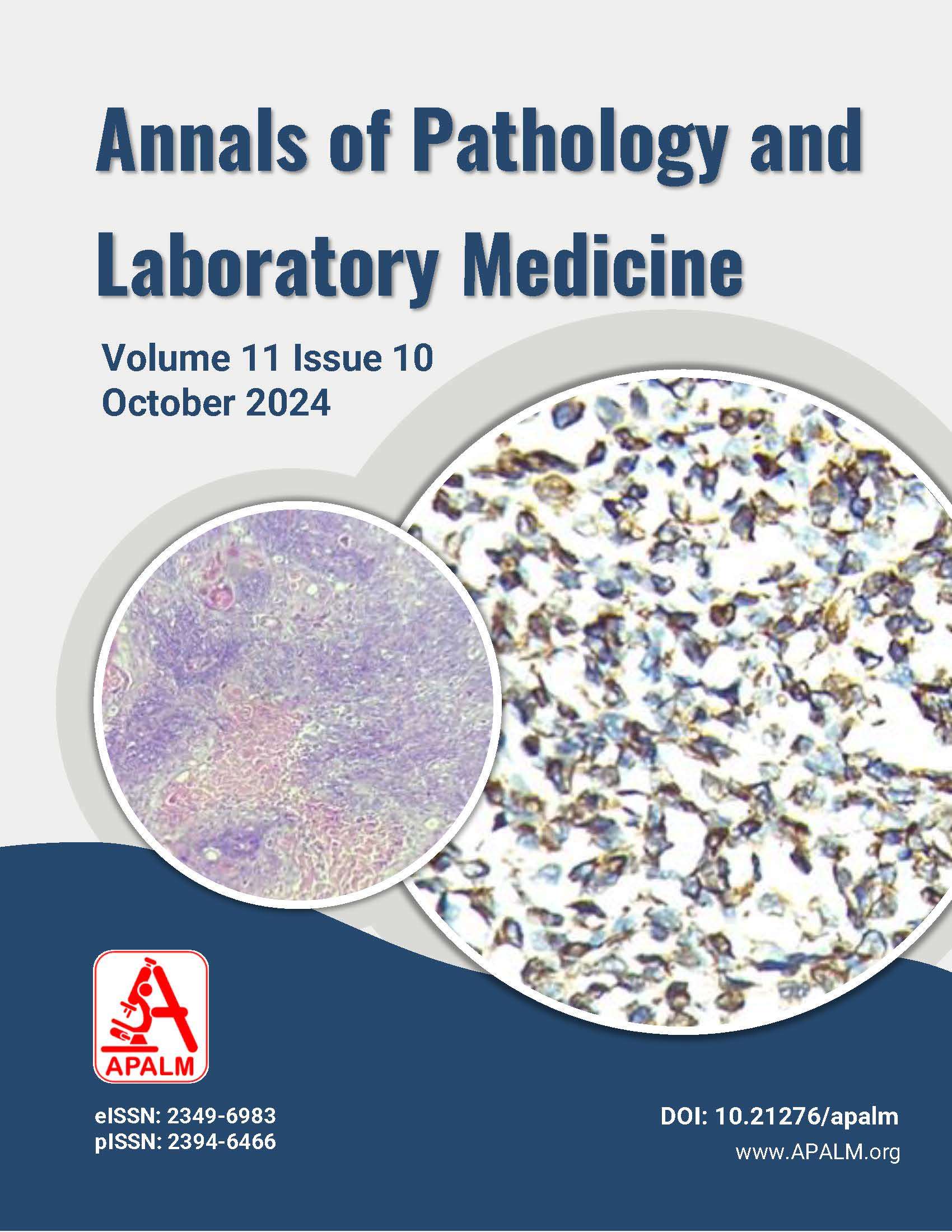Dedifferentiated Liposarcoma: A Rare Entity
DOI:
https://doi.org/10.21276/apalm.3386Keywords:
Dedifferentiated Liposarcoma, Pleomorphic Liposarcoma, Lipogenic, Non-lipogenicAbstract
Background: Dedifferentiated liposarcoma is defined as well-differentiated liposarcoma juxtaposed to areas of high-grade non-lipogenic sarcoma, usually resembling fibrosarcoma or undifferentiated pleomorphic sarcoma. The retroperitoneum is a common site; fewer than 20% of dedifferentiated liposarcomas occur in the head, neck, and rarely in the subcutis.
Case History: A 36-year-old male patient presented to the surgery department of our hospital with the chief complaint of a recurrence of a soft tissue mass over the left upper shoulder region. There is a history of a previous operation at the same site. In the MRI report, a well-defined lobulated lesion was noted in the subcutaneous plane over the left scapular region. The lesion is heterogeneously hyperintense on T2 and STIR and shows areas of cystic changes. A single globular skin-covered specimen measuring 10 x 6.0 x 5.0 cm. The outer surface of the skin is smooth, shiny, and varies in color from grey-white to grey-brown, with the lesion protruding from the skin (FIG 1). On the cut surface, a grayish, shiny, smooth, and cystic appearance is present. Multiple sections studied from the lesional tissue show both well-differentiated liposarcomatous and non-lipogenic (dedifferentiated) components. The liposarcomatous area consists of mature adipocytes and atypical spindle cells. Non-lipogenic components consist of highly cellular areas showing hemangiopericytoma-like vascular patterns, and in some places, malignant fibrous histiocytoma (MFH)-like areas are also noted.
Discussion: Dedifferentiated liposarcoma comprises less than 10% of all liposarcomas. It is found most often in the retroperitoneum and rarely in the extremities, head, and neck region. The incidence is approximately 1 in 330,000 persons per year.
References
1. Ezinger & Weiss. Dedifferentiated liposarcoma. In: Seventh edition. Chapter 17, p. 538-539.
2. Thway K. Well-differentiated liposarcoma and dedifferentiated liposarcoma: An updated review. Semin Diagn Pathol. 2019;36(2):112-121.
3. Coindre JM, Pedeutour F, Aurias A. Well-differentiated and dedifferentiated liposarcomas. Virchows Arch. 2010;456(2):167-179.
4. Dodd LG. Update on liposarcoma: a review for cytopathologists. Diagn Cytopathol. 2011.
5. Dalal KM, Kattan MW, Antonescu CR, Brennan MF, Singer S. Subtype specific prognostic nomogram for patients with primary liposarcoma of the retroperitoneum, extremity or trunk. Ann Surg. 2006;244(3):381-391.
6. Sunwoo MO, Park HY, Oh HK, Choi HY. Dedifferentiated liposarcoma of the thigh: Case report. J Korean Radiol Soc. 2002;47(5):527-531.
7. Evans HL, Khurana KK, Kemp BL, Ayala AG. Heterologous elements in the dedifferentiated component of dedifferentiated liposarcoma. Am J Surg Pathol. 1994;18:1150-1157.
8. Hoshi M, Matsumoto S, Manabe J, Tanizawa T, Shigemitsu T, Koyanagi H, et al. Surgery for dedifferentiated liposarcoma, presenting two radiologically and pathologically distinctive patterns. Jpn J Clin Oncol. 2006;36(7):462-467.
Downloads
Published
Issue
Section
License
Copyright (c) 2024 Shahnaz Bano, Bhanu Pratap Singh, Ankita Gupta

This work is licensed under a Creative Commons Attribution 4.0 International License.
Authors who publish with this journal agree to the following terms:
- Authors retain copyright and grant the journal right of first publication with the work simultaneously licensed under a Creative Commons Attribution License that allows others to share the work with an acknowledgement of the work's authorship and initial publication in this journal.
- Authors are able to enter into separate, additional contractual arrangements for the non-exclusive distribution of the journal's published version of the work (e.g., post it to an institutional repository or publish it in a book), with an acknowledgement of its initial publication in this journal.
- Authors are permitted and encouraged to post their work online (e.g., in institutional repositories or on their website) prior to and during the submission process, as it can lead to productive exchanges, as well as earlier and greater citation of published work (See The Effect of Open Access at http://opcit.eprints.org/oacitation-biblio.html).










